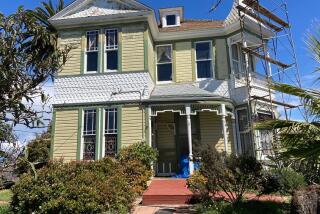Salvaging Architectural Antiques : Decorating: The Great American Salvage Co. searches out choice remnants all over the country before old structures are demolished.
- Share via
WASHINGTON — Paul Davis wants to point out that he is no champion of the wrecking ball. But he figures that if an old building has to be razed, there is no reason he shouldn’t get a piece of it.
Davis manages the local franchise of the Vermont-based Great American Salvage Co., which sends its employees all over the country in search of choice remnants from about-to-be-demolished structures. They’re not after bricks and mortar, but the old mantels, stained-glass windows, claw-foot bathtubs and Grecian columns that characterized the periods in which the structures were built. They buy them, and resell them to homeowners and designers who want to decorate with the fragments of yesterday.
“You can’t compare it with today’s materials,” Davis said, running his hand over an oak mantel in his Aldie, Va., showroom. “Why do we like antiques? They have history. They exist in a time we didn’t and in a way we didn’t. We have a strong enough architectural heritage in this country . . . we should be saving these things.”
Not that he is in it just for love. There’s a big market for architectural antiques, as they are called, and Davis is tapping it. Just two years after Great American Salvage opened in the Washington area, Davis has a computerized file of more than 1,000 clients. The clients will pay $3,200 for a cast-iron gate, circa 1840. Or $20 for a doorknob from the early 1920s. Or $725 for a china sink salvaged from the Plaza Hotel in New York.
Davis concedes these prices are negotiable. If he is inspired by a client’s decorating scheme, he might let something go for a few dollars more than what it cost him. Other times, he will hold out until someone meets his price. “Unlike the clothing business, there’s no real wholesale-retail formula in salvaging,” he said.
So what do people do with this stuff?
Myrna Firestone recently bought 32 iron pilasters--short posts--to decorate her garden and two Victorian-style balconies recently added to her Georgetown house. In their former life, the pilasters graced a turn-of-the-century state government building in Concord, N.H.
“I think they really make the balconies,” Firestone said of her purchase. “They give them that authenticity. . . . Otherwise, they might have possibly looked new, which would have been a disaster in Georgetown.”
Great American’s pieces also are available for rent. Nordstrom here recently used a carousel horse from Great American Salvage in a window display.
The owner of the Aldie franchise, John Graham of Boyce, Va., says his venture into architectural antiques has not yet turned a profit. Part of the reason is the $300,000 he recently spent to move the business from a large room in Middleburg, Va., to its present location in a two-story Victorian house on Route 50. But Graham says it’s mostly because “in this game, we turn an awful lot of money back into the material.” Once a piece is purchased, it often has to be restored before it can be resold.
Davis, who was a painting conservator and restoration consultant before coming to Great American Salvage, occasionally restores some items himself. But he spends most of his time hunting for marble statues of Japanese goddesses, hand-carved carousel horses or tin bathtubs with oak rims.
Davis also has the option of “purloining” a piece from one of four other stores, which are scattered along the East Coast.
It’s all done in the name of that paramount principle of retailing: Get the customers what they want. But Davis’ own motto probably differs from most.
“This comes down to three main points,” he said. “Salvage. Save. Sell.”




